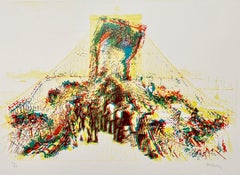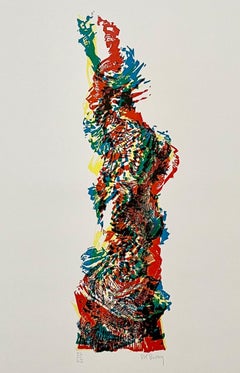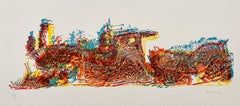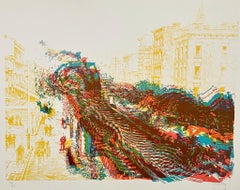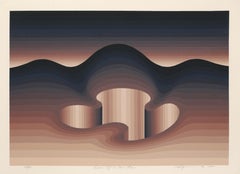Items Similar to Limited Edition Architecture Kinetic Art Op Art Screenprint Lithograph Pol Bury
Want more images or videos?
Request additional images or videos from the seller
Want more images or videos?
Request additional images or videos from the seller
1 of 11
Pol BuryLimited Edition Architecture Kinetic Art Op Art Screenprint Lithograph Pol Bury1966
1966

About the Item
Pol Bury (Belgian, 1922-2005)
Screen print of raised bridge
Hand signed and numbered 27/ 62 in pencil
Dimensions: 17.5 X 24.25 inches. (sheet size)
Provenance: Published by Lefebre Gallery, New York.
lithographie en couleurs.
Signées et numérotées 27/62.
This is just for the print. the title sheet is just included for reference.
Pol Bury (1922 – 2005) was a Belgian sculptor who began his artistic career as a painter in the Jeune Peintre Belge (along with Willy Anthoons, James Ensor, Odette Collon, Pierre Alechinsky, Jo Delahaut and Jean Rets) and COBRA groups. (Karel Appel, Constant, Corneille, Christian Dotremont, Asger Jorn etc) Among his most famous works is the fountain-sculpture L'Octagon, located in San Francisco. He was best known for his kinetic, Op Art sculptures. He began his career as a Surrealist painter influenced by the work of Rene Magritte and Yves Tanguy. Paintings he produced in the late 1930s and first half of the ’40s were included in the 1945 Exposition Internationale du Surréalisme held in Brussels. Pol Bury was born in La Louvière, Belgium,in 1922. After attending the Académie des Beaux-Arts in Mons in 1938–39, he joined a group of Surrealist poets that included Achille Chavée.
The focus of Bury’s art shifted in 1952 after he visited an exhibition featuring Alexander Calder’s work. The movement of Calder’s mobiles captivated Bury, and he began producing sculptures with moving components. These early kinetic sculptures were exhibited in the 1955 group exhibition Le Mouvement at Galerie Denise René in Paris. The exhibition proved particularly influential for the international ZERO network (active in the late 1950s and early ’60s), and Bury went on to participate in ZERO exhibitions and contribute to Heinz Mack and Otto Piene’s ZERO journal. Bury began to include electric motors in many of his sculptures in 1957. The concealed motors activate the works, prompting elements to twist, tilt, or spin. Around 1964, the artist started creating his Cinetizations: photographs and prints depicting well-known monuments, but with the architectural structure fundamentally altered. In a Cinetization featuring the Eiffel Tower, the iron structure appears to wobble as if on the brink of collapse. Bury’s sculptures and Cinetizations both demonstrate moments of physical contingency that belie gravity’s certain pull. In the late 1960s, Bury began working with stainless steel and Cor-Ten steel, polished brass, and copper. By 1969 he had created his first public fountain, at the University of Iowa Museum of Art.
He was included in the influential 1975 MoMA show Prints by Sculptors along with Alexander Archipenko, Jean (Hans) Arp, Lee Bontecou, Louise Bourgeois, Alexander Calder, Christo, Barbara Hepworth, Henry Moore, Louise Nevelson, Eduardo Paolozzi, Niki de Saint Phalle and Richard Serra. His early kinetic art sculptures were exhibited in the 1955 group exhibition Le Mouvement at Galerie Denise Rene in Paris. Artists, who experimented with motion, such as Alexander Calder, Marcel Duchamp, Yaacov Agam, Pol Bury, Jesus Rafael Soto, Jean Tinguely, and Victor Vasarely. With Lefebre Gallery X Cinetizations Portfolio, 1966. He also published large silkscreen works on canvas with Brooke Alexander gallery. His work is present in the permanent collection of numerous museums worldwide.Retrospectives featuring the artist’s work have been organized by the University Art Museum, University of California, Berkeley, in collaboration with the Solomon R. Guggenheim Museum, New York (1970); Museo de Arte Moderno in Mexico City (1977–78); Musée d’art moderne de la Ville de Paris (1982); and Josef Albers Museum in Bottrop, Germany (1990). Bury died on September 27, 2005, in Paris.
- Creator:Pol Bury (1922 - 2005, Belgian)
- Creation Year:1966
- Dimensions:Height: 17.5 in (44.45 cm)Width: 24.25 in (61.6 cm)
- Medium:
- Movement & Style:
- Period:
- Condition:Refer to photos.
- Gallery Location:Surfside, FL
- Reference Number:1stDibs: LU38214796102
Pol Bury
Pol Bury (26 April 1922 – 28 September 2005) was a Belgian sculptor who began his artistic career as a painter in the Jeune Peintre Belge and COBRA groups. Among his most famous works is the fountain-sculpture L'Octagon, located in San Francisco.
About the Seller
4.9
Platinum Seller
These expertly vetted sellers are 1stDibs' most experienced sellers and are rated highest by our customers.
Established in 1995
1stDibs seller since 2014
1,682 sales on 1stDibs
Typical response time: 2 hours
- ShippingRetrieving quote...Ships From: Surfside, FL
- Return PolicyA return for this item may be initiated within 3 days of delivery.
Authenticity Guarantee
In the unlikely event there’s an issue with an item’s authenticity, contact us within 1 year for a full refund. DetailsMoney-Back Guarantee
If your item is not as described, is damaged in transit, or does not arrive, contact us within 7 days for a full refund. Details24-Hour Cancellation
You have a 24-hour grace period in which to reconsider your purchase, with no questions asked.Vetted Professional Sellers
Our world-class sellers must adhere to strict standards for service and quality, maintaining the integrity of our listings.Price-Match Guarantee
If you find that a seller listed the same item for a lower price elsewhere, we’ll match it.Trusted Global Delivery
Our best-in-class carrier network provides specialized shipping options worldwide, including custom delivery.More From This Seller
View AllPop Art Aspen Road Sign D'arcangelo Silkscreen Chiron Press Vintage Art Poster
Located in Surfside, FL
Allan D'Arcangelo (American/New York, 1930-1998),
"Aspen Center of Contemporary Art",
1967
silkscreen, hand signed in pencil, dated, numbered "45/200" and blind stamped "Chiron Press, New York, NY"
32 in. x 24 in.
Allan D'Arcangelo (1930-1998) was an American artist and printmaker, best known for his paintings of highways and road signs that border on pop art and minimalism, precisionism, Abstract illusionism and hard-edge painting, and also surrealism. His subject matter is distinctly American and evokes, at times, a cautious outlook on the future of this country. Allan D'Arcangelo was the son of Italian immigrants. He studied at the University of Buffalo from 1948–1953, where he got his bachelor's degree in history. After college, he moved to Manhattan and picked up his studies again at the New School of Social Research and the City University of New York, City College. At this time, he encountered Abstract Expressionist painters who were in vogue at the moment. After joining the army in the mid 1950s, he used the GI Bill to study painting at Mexico City College from 1957–59, driving there over 12 days in an old bakery truck retrofitted as a camper. However, he returned to New York in 1959, in search of the unique American experience. It was at this time that his painting took on a cool sensibility reminiscent of Roy Lichtenstein and Andy Warhol. His interests engaged with the environment, anti-Vietnam War protests, and the commodification and objectification of female sexuality. D'Arcangelo first achieved recognition in 1962, when he was invited to contribute an etching to The International Anthology of Contemporary Engraving: America Discovered; his first solo exhibition came the next year, at the Thiebaud Gallery in New York City. In 1965 he contributed three screenprints to Original Edition's 11 Pop Artists portfolio. By the 1970s, D'Arcangelo had received significant recognition in the art world. He was well known for his paintings of quintessentially American highways and infrastructure, and in 1971 was commissioned by the Department of the Interior to paint the Grand Coulee Dam in Washington state. However, his sense of morality always trumped his interest in art world fame. In 1975, he decided to quit the gallery that had been representing him for years, Marlborough Gallery, because of the way they handled Mark Rothko legacy.
D'Arcangelo rejected Abstract Expressionism, though his early work has a painterly and somewhat expressive feel. He quickly turned to a style of art that seemed to border on Pop Art and Minimalism, Precisionism and Hard-Edge painting. Evidently, he didn't fit neatly in the category of Pop Art, though he shared subjects (women, signs, Superman) and techniques (stencil, assemblage) with these artists.He turned to expansive, if detached scenes of the American highway. These paintings are reminiscent of Giorgio de Chirico-though perhaps not as interested in isolation-and Salvador Dali-though there is a stronger interest in the present and disinterest in the past. These paintings also have a sharp quality that is reminiscent of the precisionist style, or more specifically, Charles Sheeler. 1950s, Before D'Arcangelo returned to New York, his style was roughly figurative and reminiscent of folk art. During the early 1960s, Allan D'Arcangelo was linked with Pop Art. "Marilyn" (1962) depicts an illustrative head and shoulders on which the facial features are marked by lettered slits to be "fitted" with the eyebrows, eyes, nose and mouth which appear off to the right in the composition. In "Madonna and Child," (1963) the featureless faces of Jackie Kennedy and Caroline are ringed with haloes, enough to make their status as contemporary icons perfectly clear.
Select Exhibitions:
Fischbach Gallery, New York,
Ileana Sonnabend Gallery, Paris,
Gallery Müller, Stuttgart, Germany
Hans Neuendorf Gallery, Hamburg, Germany
Dwan Gallery...
Category
1960s Pop Art Abstract Prints
Materials
Lithograph, Screen
Architecture Kinetic New York Brooklyn Bridge Op Art Lithograph Pol Bury Ltd Ed
By Pol Bury
Located in Surfside, FL
Pol Bury (Belgian, 1922-2005)
Screen print of Brooklyn Bridge
Hand signed and numbered 27/ 62 in pencil
Dimensions: 17.5 X 24.25 inches. (sheet size)
Provenance: Published by Lefebre Gallery, New York.
lithographie en couleurs.
Signées et numérotées 27/62.
This is just for the print. the title sheet is just included for reference.
Pol Bury (1922 – 2005) was a Belgian sculptor who began his artistic career as a painter in the Jeune Peintre Belge (along with Willy Anthoons, James Ensor, Odette Collon, Pierre Alechinsky, Jo Delahaut and Jean Rets...
Category
1960s Op Art Landscape Prints
Materials
Lithograph, Screen
Architecture Kinetic Statue of Liberty Op Art Screen Print Lithograph Pol Bury
By Pol Bury
Located in Surfside, FL
Pol Bury (Belgian, 1922-2005)
screen print of Statue of Liberty
Hand signed and numbered 27/ 62 in pencil
Dimensions: 24.25 X 17.5 inches. (sheet size)
Provenance: Published by Lefebre Gallery, New York.
lithographie en couleurs.
Signées et numérotées 27/62.
This is just for the print. the title sheet is just included for reference.
Pol Bury (1922 – 2005) was a Belgian sculptor who began his artistic career as a painter in the Jeune Peintre Belge (along with Willy Anthoons, James Ensor, Odette Collon, Pierre Alechinsky, Jo Delahaut and Jean Rets...
Category
1960s Op Art Landscape Prints
Materials
Lithograph, Screen
Limited Edition Architecture Kinetic Art Op Art Screenprint Lithograph Pol Bury
By Pol Bury
Located in Surfside, FL
Pol Bury (Belgian, 1922-2005)
screen print of a train
Hand signed and numbered 27/ 62 in pencil
Dimensions: 17.5 X 24.25 inches. (sheet size)
Provenance: Published by Lefebre Gallery, New York.
lithographie en couleurs.
Signées et numérotées 27/62.
This is just for the print. the title sheet is just included for reference.
Pol Bury (1922 – 2005) was a Belgian sculptor who began his artistic career as a painter in the Jeune Peintre Belge (along with Willy Anthoons, James Ensor, Odette Collon, Pierre Alechinsky, Jo Delahaut and Jean Rets...
Category
1960s Op Art Landscape Prints
Materials
Lithograph, Screen
Limited Edition Architecture Kinetic Op Art Screen Print Lithograph Pol Bury
By Pol Bury
Located in Surfside, FL
Pol Bury (Belgian, 1922-2005)
screen print
Hand signed and numbered 27/ 62 in pencil
Dimensions: 17.5 X 24.25 inches. (sheet size)
Provenance: Published by Lefebre Gallery, New York.
lithographie en couleurs.
Signées et numérotées 27/62.
This is just for the print. the title sheet is just included for reference.
Pol Bury (1922 – 2005) was a Belgian sculptor who began his artistic career as a painter in the Jeune Peintre Belge (along with Willy Anthoons, James Ensor, Odette Collon, Pierre Alechinsky, Jo Delahaut and Jean Rets...
Category
1960s Op Art Landscape Prints
Materials
Lithograph, Screen
Michael Gross Israeli Minimalist Conceptual Art, Abstract Jerusalem Silkscreen
By Michael Gross
Located in Surfside, FL
Michael Gross (Hebrew: מיכאל גרוס; 1920 – 4 November 2004) was an Israeli painter, sculptor and conceptual artist.
Michael Gross was born in Tiberias in the British-administered Palestine in 1920. He grew up in the farming village of Migdal. In 1939-1940, he left to study at the Teachers’ Training College in Jerusalem. In 1939, while he was away, his father was murdered by Arabs, and the family farm and home were destroyed. This event impacted on his work as an artist.
From 1943 to 1945, he studied architecture at Technion – Israel Institute of Technology in Haifa. From 1951 to 1954, he studied art at the École nationale supérieure des Beaux-Arts in Paris. He returned to Israel in 1954 and settled in the artists’ village of Ein Hod.
Gross's works are imbued with the light and spirit. They are minimalist, but never pure abstraction, always tied to natural form and laden with feeling. In his early paintings, Gross simplified form in order to concentrate on proportion, broad areas of color, and the size and placement of each element. This reductive process was also notable in his sculptures, whether in painted iron or other materials such as white concrete. In later paintings, he often juxtaposed large off-white panels with patches of tone, adding textured materials such as wooden beams, burlap and rope. Gross’s rough, freely-brushed surfaces, along with the use of soft pastel coloring, conjure up images of the Israeli landscape.
Education
1936-1940 Teachers Seminary, Jerusalem
1943-1945, Technion, Haifa, architecture, studied sculpture with Moshe Ziffer.
1951-1954 Beaux Arts, Paris with Michel Guimond
Teaching
1954 - 1954 Higher School of Education, Haifa.
1957-1960 Bezalel Academy of Arts and Design, Jerusalem
1960-1980 Oranim Art Institute, Tivon
Awards
1964: Hermann Struck Prize
1967: Dizengoff Prize
1971...
Category
1970s Modern Landscape Prints
Materials
Lithograph, Screen
Pop Art Aspen Road Sign D'arcangelo Silkscreen Chiron Press Vintage Art Poster
Located in Surfside, FL
Allan D'Arcangelo (American/New York, 1930-1998),
"Aspen Center of Contemporary Art",
1967
silkscreen, hand signed in pencil, dated, numbered "45/200" and blind stamped "Chiron Press, New York, NY"
32 in. x 24 in.
Allan D'Arcangelo (1930-1998) was an American artist and printmaker, best known for his paintings of highways and road signs that border on pop art and minimalism, precisionism, Abstract illusionism and hard-edge painting, and also surrealism. His subject matter is distinctly American and evokes, at times, a cautious outlook on the future of this country. Allan D'Arcangelo was the son of Italian immigrants. He studied at the University of Buffalo from 1948–1953, where he got his bachelor's degree in history. After college, he moved to Manhattan and picked up his studies again at the New School of Social Research and the City University of New York, City College. At this time, he encountered Abstract Expressionist painters who were in vogue at the moment. After joining the army in the mid 1950s, he used the GI Bill to study painting at Mexico City College from 1957–59, driving there over 12 days in an old bakery truck retrofitted as a camper. However, he returned to New York in 1959, in search of the unique American experience. It was at this time that his painting took on a cool sensibility reminiscent of Roy Lichtenstein and Andy Warhol. His interests engaged with the environment, anti-Vietnam War protests, and the commodification and objectification of female sexuality. D'Arcangelo first achieved recognition in 1962, when he was invited to contribute an etching to The International Anthology of Contemporary Engraving: America Discovered; his first solo exhibition came the next year, at the Thiebaud Gallery in New York City. In 1965 he contributed three screenprints to Original Edition's 11 Pop Artists portfolio. By the 1970s, D'Arcangelo had received significant recognition in the art world. He was well known for his paintings of quintessentially American highways and infrastructure, and in 1971 was commissioned by the Department of the Interior to paint the Grand Coulee Dam in Washington state. However, his sense of morality always trumped his interest in art world fame. In 1975, he decided to quit the gallery that had been representing him for years, Marlborough Gallery, because of the way they handled Mark Rothko legacy.
D'Arcangelo rejected Abstract Expressionism, though his early work has a painterly and somewhat expressive feel. He quickly turned to a style of art that seemed to border on Pop Art and Minimalism, Precisionism and Hard-Edge painting. Evidently, he didn't fit neatly in the category of Pop Art, though he shared subjects (women, signs, Superman) and techniques (stencil, assemblage) with these artists.He turned to expansive, if detached scenes of the American highway. These paintings are reminiscent of Giorgio de Chirico-though perhaps not as interested in isolation-and Salvador Dali-though there is a stronger interest in the present and disinterest in the past. These paintings also have a sharp quality that is reminiscent of the precisionist style, or more specifically, Charles Sheeler. 1950s, Before D'Arcangelo returned to New York, his style was roughly figurative and reminiscent of folk art. During the early 1960s, Allan D'Arcangelo was linked with Pop Art. "Marilyn" (1962) depicts an illustrative head and shoulders on which the facial features are marked by lettered slits to be "fitted" with the eyebrows, eyes, nose and mouth which appear off to the right in the composition. In "Madonna and Child," (1963) the featureless faces of Jackie Kennedy and Caroline are ringed with haloes, enough to make their status as contemporary icons perfectly clear.
Select Exhibitions:
Fischbach Gallery, New York,
Ileana Sonnabend Gallery, Paris,
Gallery Müller, Stuttgart, Germany
Hans Neuendorf Gallery, Hamburg, Germany
Dwan Gallery...
Category
1960s Pop Art Abstract Prints
Materials
Lithograph, Screen
Architecture Kinetic New York Brooklyn Bridge Op Art Lithograph Pol Bury Ltd Ed
By Pol Bury
Located in Surfside, FL
Pol Bury (Belgian, 1922-2005)
Screen print of Brooklyn Bridge
Hand signed and numbered 27/ 62 in pencil
Dimensions: 17.5 X 24.25 inches. (sheet size)
Provenance: Published by Lefebre Gallery, New York.
lithographie en couleurs.
Signées et numérotées 27/62.
This is just for the print. the title sheet is just included for reference.
Pol Bury (1922 – 2005) was a Belgian sculptor who began his artistic career as a painter in the Jeune Peintre Belge (along with Willy Anthoons, James Ensor, Odette Collon, Pierre Alechinsky, Jo Delahaut and Jean Rets...
Category
1960s Op Art Landscape Prints
Materials
Lithograph, Screen
Architecture Kinetic Statue of Liberty Op Art Screen Print Lithograph Pol Bury
By Pol Bury
Located in Surfside, FL
Pol Bury (Belgian, 1922-2005)
screen print of Statue of Liberty
Hand signed and numbered 27/ 62 in pencil
Dimensions: 24.25 X 17.5 inches. (sheet size)
Provenance: Published by Lefebre Gallery, New York.
lithographie en couleurs.
Signées et numérotées 27/62.
This is just for the print. the title sheet is just included for reference.
Pol Bury (1922 – 2005) was a Belgian sculptor who began his artistic career as a painter in the Jeune Peintre Belge (along with Willy Anthoons, James Ensor, Odette Collon, Pierre Alechinsky, Jo Delahaut and Jean Rets...
Category
1960s Op Art Landscape Prints
Materials
Lithograph, Screen
Limited Edition Architecture Kinetic Art Op Art Screenprint Lithograph Pol Bury
By Pol Bury
Located in Surfside, FL
Pol Bury (Belgian, 1922-2005)
screen print of a train
Hand signed and numbered 27/ 62 in pencil
Dimensions: 17.5 X 24.25 inches. (sheet size)
Provenance: Published by Lefebre Gallery, New York.
lithographie en couleurs.
Signées et numérotées 27/62.
This is just for the print. the title sheet is just included for reference.
Pol Bury (1922 – 2005) was a Belgian sculptor who began his artistic career as a painter in the Jeune Peintre Belge (along with Willy Anthoons, James Ensor, Odette Collon, Pierre Alechinsky, Jo Delahaut and Jean Rets...
Category
1960s Op Art Landscape Prints
Materials
Lithograph, Screen
Limited Edition Architecture Kinetic Op Art Screen Print Lithograph Pol Bury
By Pol Bury
Located in Surfside, FL
Pol Bury (Belgian, 1922-2005)
screen print
Hand signed and numbered 27/ 62 in pencil
Dimensions: 17.5 X 24.25 inches. (sheet size)
Provenance: Published by Lefebre Gallery, New York.
lithographie en couleurs.
Signées et numérotées 27/62.
This is just for the print. the title sheet is just included for reference.
Pol Bury (1922 – 2005) was a Belgian sculptor who began his artistic career as a painter in the Jeune Peintre Belge (along with Willy Anthoons, James Ensor, Odette Collon, Pierre Alechinsky, Jo Delahaut and Jean Rets...
Category
1960s Op Art Landscape Prints
Materials
Lithograph, Screen
Michael Gross Israeli Minimalist Conceptual Art, Abstract Jerusalem Silkscreen
By Michael Gross
Located in Surfside, FL
Michael Gross (Hebrew: מיכאל גרוס; 1920 – 4 November 2004) was an Israeli painter, sculptor and conceptual artist.
Michael Gross was born in Tiberias in the British-administered Palestine in 1920. He grew up in the farming village of Migdal. In 1939-1940, he left to study at the Teachers’ Training College in Jerusalem. In 1939, while he was away, his father was murdered by Arabs, and the family farm and home were destroyed. This event impacted on his work as an artist.
From 1943 to 1945, he studied architecture at Technion – Israel Institute of Technology in Haifa. From 1951 to 1954, he studied art at the École nationale supérieure des Beaux-Arts in Paris. He returned to Israel in 1954 and settled in the artists’ village of Ein Hod.
Gross's works are imbued with the light and spirit. They are minimalist, but never pure abstraction, always tied to natural form and laden with feeling. In his early paintings, Gross simplified form in order to concentrate on proportion, broad areas of color, and the size and placement of each element. This reductive process was also notable in his sculptures, whether in painted iron or other materials such as white concrete. In later paintings, he often juxtaposed large off-white panels with patches of tone, adding textured materials such as wooden beams, burlap and rope. Gross’s rough, freely-brushed surfaces, along with the use of soft pastel coloring, conjure up images of the Israeli landscape.
Education
1936-1940 Teachers Seminary, Jerusalem
1943-1945, Technion, Haifa, architecture, studied sculpture with Moshe Ziffer.
1951-1954 Beaux Arts, Paris with Michel Guimond
Teaching
1954 - 1954 Higher School of Education, Haifa.
1957-1960 Bezalel Academy of Arts and Design, Jerusalem
1960-1980 Oranim Art Institute, Tivon
Awards
1964: Hermann Struck Prize
1967: Dizengoff Prize
1971...
Category
1970s Modern Landscape Prints
Materials
Lithograph, Screen
About
Details
- Creator:Pol Bury (1922 - 2005, Belgian)
- Creation Year:1966
- Dimensions:Height: 17.5 in (44.45 cm)Width: 24.25 in (61.6 cm)
- Medium:
- Movement & Style:
- Period:
- Condition:Refer to photos.
- Gallery Location:Surfside, FL
- Reference Number:1stDibs: LU38214796102
You May Also Like
Thunder Bay
By Roy Ahlgren
Located in San Francisco, CA
This artwork titled "Thunder Bay" 1986 is a color serigraph on Wove paper by noted American artist Roy Ahlgren, 1927-2011 It is hand signed, titled, dated and numbered 14/95 in penci...
Category
Mid-20th Century Op Art Abstract Prints
Materials
Screen
Dawn of a New Era, Op Art Abstract Screenprint by Roy Ahlgren
By Roy Ahlgren
Located in Long Island City, NY
Artist: Roy Ahlgren, American (1927 - 2011)
Title: Dawn of a New Era
Year: 1980
Medium: Serigraph, signed and numbered in pencil
Edition: 145
Image Size: 18 x 25 inches
Size: 22 x 29...
Category
1980s Op Art Abstract Prints
Materials
Screen
Aftermath
By Roy Ahlgren
Located in San Francisco, CA
This artwork titled "Aftermath" 1981 is a color serigraph on Wove paper by noted American artist Roy Ahlgren, 1927-2011 It is hand signed, titled, dated and numbered 2/150in pencil b...
Category
Mid-20th Century Op Art Abstract Prints
Materials
Screen
Aztec
By Roy Ahlgren
Located in San Francisco, CA
This artwork titled "Aztec" 1983 is a color serigraph on Wove paper by noted American artist Roy Ahlgren, 1927-2011 It is hand signed, titled, dated and numbered 71/150 in pencil by ...
Category
Mid-20th Century Op Art Abstract Prints
Materials
Screen
Gull Point
By Roy Ahlgren
Located in San Francisco, CA
This artwork titled "Gull Point" 1987 is a color serigraph by noted American artist Roy Ahlgren, 1927-2011 It is hand signed, titled, dated and numbered 60/100 in pencil by the artis...
Category
Mid-20th Century Op Art Abstract Prints
Materials
Screen
Awakening
By Roy Ahlgren
Located in San Francisco, CA
This artwork titled "Awakening" 1981 is a color serigraph on Wove paper by noted American artist Roy Ahlgren, 1927-2011 It is hand signed, titled, dated and numbered 70/150 in pencil...
Category
Mid-20th Century Op Art Abstract Prints
Materials
Screen
Thunder Bay
By Roy Ahlgren
Located in San Francisco, CA
This artwork titled "Thunder Bay" 1986 is a color serigraph on Wove paper by noted American artist Roy Ahlgren, 1927-2011 It is hand signed, titled, dated and numbered 14/95 in penci...
Category
Mid-20th Century Op Art Abstract Prints
Materials
Screen
Dawn of a New Era, Op Art Abstract Screenprint by Roy Ahlgren
By Roy Ahlgren
Located in Long Island City, NY
Artist: Roy Ahlgren, American (1927 - 2011)
Title: Dawn of a New Era
Year: 1980
Medium: Serigraph, signed and numbered in pencil
Edition: 145
Image Size: 18 x 25 inches
Size: 22 x 29...
Category
1980s Op Art Abstract Prints
Materials
Screen
Aftermath
By Roy Ahlgren
Located in San Francisco, CA
This artwork titled "Aftermath" 1981 is a color serigraph on Wove paper by noted American artist Roy Ahlgren, 1927-2011 It is hand signed, titled, dated and numbered 2/150in pencil b...
Category
Mid-20th Century Op Art Abstract Prints
Materials
Screen
Aztec
By Roy Ahlgren
Located in San Francisco, CA
This artwork titled "Aztec" 1983 is a color serigraph on Wove paper by noted American artist Roy Ahlgren, 1927-2011 It is hand signed, titled, dated and numbered 71/150 in pencil by ...
Category
Mid-20th Century Op Art Abstract Prints
Materials
Screen
Gull Point
By Roy Ahlgren
Located in San Francisco, CA
This artwork titled "Gull Point" 1987 is a color serigraph by noted American artist Roy Ahlgren, 1927-2011 It is hand signed, titled, dated and numbered 60/100 in pencil by the artis...
Category
Mid-20th Century Op Art Abstract Prints
Materials
Screen
Awakening
By Roy Ahlgren
Located in San Francisco, CA
This artwork titled "Awakening" 1981 is a color serigraph on Wove paper by noted American artist Roy Ahlgren, 1927-2011 It is hand signed, titled, dated and numbered 70/150 in pencil...
Category
Mid-20th Century Op Art Abstract Prints
Materials
Screen
More Ways To Browse
Jean James Sculpture
Iron Bridge
The Iron Bridge
Christian Dior Limited Edition
Christian Dior 1957
Brass Cobra
Vintage Copper Fountain
Christian Dior Stainless
Jean Arp Brass
Octagon Fountain
Octagonal Fountain
Vintage Electric Motors
Large Copper Fountain
Enid Morris
Ennaia Lock Modern Dynamic Standing
Enrique Echeverria
Enrique Linares
Ente Bronze










